 Getty Images
Getty Images
Two hundred years ago, it helped spread people, ideas and goods across the US. Now, it's become a paddler's paradise with more than 700 miles of continuous, navigable waterways.
Inside Lock 11 on the Erie Canal in Amsterdam, New York, the metal-on-metal grinding of gears signalled the closing of the gate behind us. With our teal kayaks lined up along the walls of the lock – an aquatic "lift" that raises or lowers boats on sections of the canal where water levels are unequal – we looked like a befuddled shiver of sharks. "Is it too late to go back?" the paddler behind me whispered, hands gripping the rope hanging along the wall beside her, as the water began to drain.
Ten women and men had come out on a sunny June morning to take part in On the Canals, a state-funded recreational programme along the Erie: the US' most important manmade waterway, which celebrates its bicentennial in 2025.
A voice at the front of the group sang out the opening of the popular American folk tune: "Low bridge, everybody down" / "I've got a mule, and her name is Sal."
"Fifteen miles on the Erie Canal!" we shouted back.
The front gates opened, and we dug in against the current spilling over Amsterdam's massive movable dam. I pulled up alongside the nervous kayaker. "What did you think?" I asked.
Above the sound of rushing water, she shouted, "I think that was the coolest thing I've ever done."
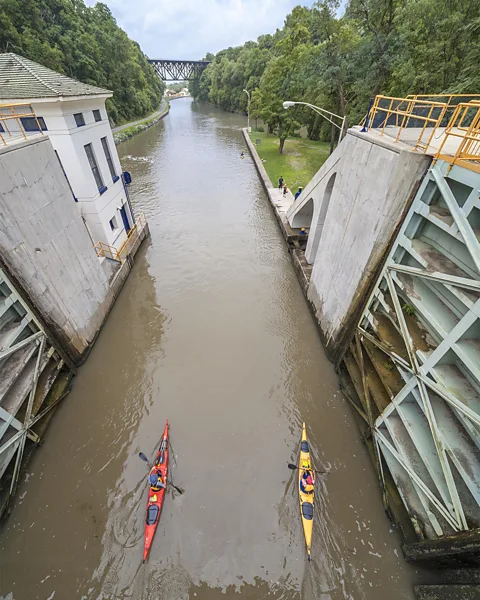 Alamy
Alamy
Two hundred years of history
For decades after it opened in 1825, upstate New York's 363-mile Erie Canal, which links the city of Buffalo, on Lake Erie in the west, to the state's capital, Albany, on the Hudson River in the east, was an engineering marvel unrivalled in North America. By connecting the Great Lakes in the Midwest to New York City, the manmade waterway precipitated the mass movement of goods, ideas and people across the country. It not only transformed New York City (which is celebrating its 400th anniversary in 2024) into the US' main seaport and an industrial juggernaut, but it also opened up the interior of the young country to settlement.
If [it was] not the most important manmade development of the 19th Century, this one set the stage – Brad Utter
The building of the canal marked the first large-scale, government-backed civil engineering project in US history and it was in constant commercial use into the 20th Century. As Brad Utter, senior historian and curator at Albany's New York State Museum and author of the book Enterprising Waters: New York's Erie Canal proclaimed, "If [it was] not the most important manmade development of the 19th Century, this one set the stage."
Utter compares the Erie Canal's historical influence to the internet today. "Prior to the Erie, if you were in Rochester and wanted something from New York City, you'd be looking at a month, maybe two, to get it," he said. "Once the canal opened, you could get it in a week, maybe two. It was, and still is, all about getting things faster, going places faster, shrinking time and space."
Railroads eventually supplanted most of the shipping along the waterway, which was designated the Erie Canalway Heritage Corridor in 2000. As it approaches its 200th anniversary, the canal is experiencing a renaissance as a paddler's paradise. It connects directly with three north-south-running historic canals – the Champlain, Oswego and Cayuga-Seneca – plus the Hudson River, creating a more than 700-mile continuous, navigable waterway.

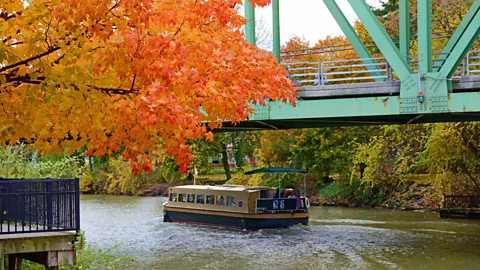 Alamy
Alamy
In 2021, the New York Power Authority/Canal Corporation, which owns and operates the Erie, launched On the Canals as a series of free excursions for state residents. Most included a combination of cycling along the newly completed Empire State Trail and paddling, hydrobiking or boating along the Erie.
The programme has since expanded to include a range of free, year-round activities for residents and visitors, from historical boat cruises to plein air painting and a full-moon "owl prowl". This year's programme will emphasise accessibility via adaptive kayaking, and highlight the stories of the Haudenosaunee Confederacy, whose members were displaced during canal construction.
Recreational renaissance
Beyond enticing people to get out on the water, On the Canals encourages exploration in more than 200 historic canalside communities – from tiny, scenic Medina, 50 miles east of Buffalo, to the city of Schenectady, whose Stockade district has 40-plus homes that are more than 200 years old. These landscapes vary from historic city centres to generations-old family farms and tranquil open fields. While some paddlers prefer to camp, others take advantage of in-town accommodations like hotels and B&Bs.
For me, post-paddle exploration meant a ramble around Amsterdam, a gem of a small city (population 18,000) with a lovely waterfront; a castle-like 19th-Century armory-turned-hotel; and a park, complete with a waterfall named for native son and Hollywood icon Kirk Douglas.

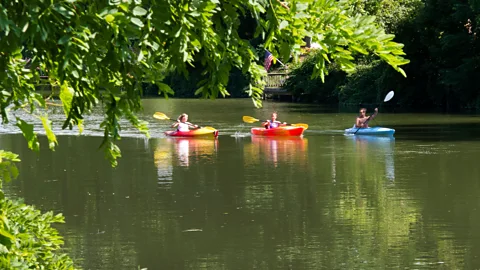 Alamy
Alamy
For others, paddling the Erie is a way to connect with a personal history. Paul Comstock, a Geneva, New York‒born septuagenarian, told me about the inspiration for his 21-day trip across the canal in 2013. Comstock's maternal grandfather, who died before he was born, worked on the waterway. "I thought, 'What an opportunity to do a multi-day paddle, and get to know this guy who was not really well-thought-of in the family,'" Comstock said. He was so taken with the experience, especially the diversity of people he met along the way, that he has returned each summer to lead paddling tours.
The sense of connecting and sharing experiences along the canal isn't surprising, Utter said. "There were big ideas happening here: suffrage, abolition, temperance, utopian religious communities, the anti-Mason movement. A lot of these took hold along the canal corridor, where they were able to travel quickly," he said.
Beth Walker and Sara Catalano (no relation to the author), a mother-daughter paddling team behind the Instagram account Two Gals on the Canal, developed new relationships as they kayaked the entire 363-mile length of the Erie, in segments, over a two-year period. In particular, Catalano told me, "The generational history and the amount of pride the lock operators have in their work, and their ability to share stories with us and give recommendations, has been really lovely. They are so invested in the upkeep of the canal and its history."
Plotting your paddle
Thanks to its calm waters and straightforward route, the Erie Canal is suitable for paddlers of all levels. "Most of the canal is fairly predictable," Catalano said. "It's hard to get lost. There are portions that can be a little rougher, such as around the Mohawk or Niagara rivers, but if you check the weather and wind in advance, it's quite safe." Comstock agrees, and recommends using Google Maps to plot distances and, by zooming in, to pinpoint public boat launches and pull-outs.

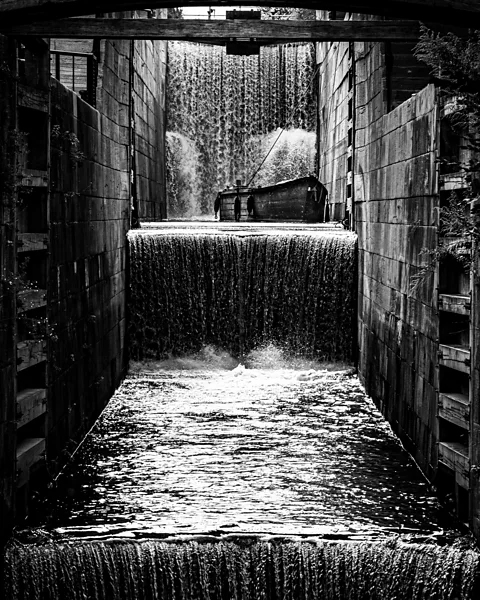 Getty Images
Getty Images
For Walker, planning is part of the fun. She especially enjoys being "able to sit down and say, 'How are we going to break this section up? Where are we going to stay? What are some good restaurants in the area that we can look forward to?'" she said.
Kayaking the canal
Those without their own kayaks can find plenty of boat-rental opportunities near the Erie Canal. Genessee Waterways Center and Lock 32, on the western end of the canal, rents kayaks (single and tandem), canoes and stand-up paddle boards (SUPs). For central-canal kayak and SUP rentals, try Anglers' Bay. In the east, Upstate Kayak Rentals has a number of fully staffed locations, as well as self-service kiosks where advance purchase gains you access, via a combination code, to a pair of kayaks, paddles and life vests.
The westernmost of three canal segments, Buffalo to Syracuse, has 15 100-year-old lift bridges whose flat decks are raised to accommodate passing boats. This section is also home to the canal's most iconic lock, the Flight of Five in the town of Lockport. Built in 1862, the multi-stepped boat elevator looks like a towering manmade waterfall, and it once hoisted boats 60ft over the Niagara Escarpment, the same geologic formation that gave rise to Niagara Falls. In Rochester, where the canal intersects with the Genesse River and Red Creek, visitors can stop at Genessee Valley Park, an 800-acre green space designed by Frederick Law Olmsted, the father of American landscape architecture, who designed New York City's Central Park.
The central portion of the canal encompasses Syracuse to Little Falls. Syracuse's Armory Square is the city's food and bar hot spot. A 10-minute walk away, don't miss the Erie Canal Museum, which is housed in the historic Syracuse Weighlock, a mid-1800s Greek Revival structure where canal boats were once weighed and charged tolls for their cargo.
For those who prefer to paddle in upstate New York's scenic wine country, head to the Finger Lakes via the Cayuga-Seneca Canal. Tour the tranquil Montezuma Wildlife Refuge, a habitat for millions of migratory and year-round birds and waterfowl, from snow geese and sandhill cranes to cerulean warblers and wigeons.

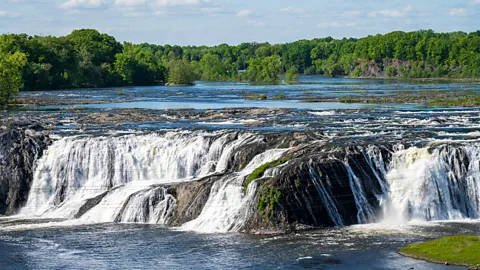 Getty Images
Getty Images
Between Little Falls and Albany, look for the remnants of a 630ft aqueduct at Schoharie Crossing State Historic Site in Fort Hunter. In Waterford, see the Waterford Flight, another multi-step lock that helps boats bypass Cohoes Falls, the second-highest waterfall in New York State. Head south for a turn around the underrated Peebles Island State Park. Or paddle into the Hudson River to explore Troy, which has one of the largest concentrations of Gilded Age architecture in the country, and capital city Albany, home to a burgeoning food and craft beer, cider and spirits movement.
Ultimately, Comstock said, paddling the Erie Canal is as much about going the distance as it is about personal discovery. "You've got all these communities along the way where you're going to interact with people at a restaurant, a museum, a park. That is the meaning of the journey," he said.
"You can go on almost any river or lake system and paddle for 12 miles, but you can't have that multi-dimensional experience of history, mileage and people as you can have on the Erie Canal."
Slowcomotion is a BBC Travel series that celebrates slow, self-propelled travel and invites readers to get outside and reconnect with the world in a safe and sustainable way.
--
If you liked this story, sign up for The Essential List newsletter – a handpicked selection of features, videos and can't-miss news, delivered to your inbox twice a week.
For more Travel stories from the BBC, follow us on Facebook, X and Instagram.